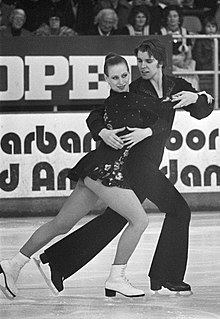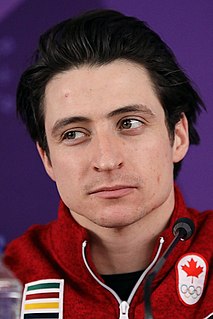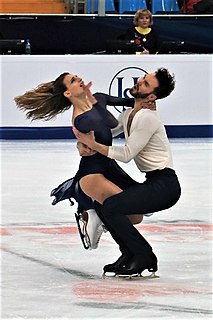
Figure skating is a sport in which individuals, pairs, or groups perform on figure skates on ice. It was the first winter sport to be included in the Olympic Games, when contested at the 1908 Olympics in London. The Olympic disciplines are men's singles, women's singles, pair skating, and ice dance; the four individual disciplines are also combined into a team event, first included in the Winter Olympics in 2014. The non-Olympic disciplines include synchronized skating, Theater on Ice, and four skating. From intermediate through senior-level competition, skaters generally perform two programs, which, depending on the discipline, may include spins, jumps, moves in the field, lifts, throw jumps, death spirals, and other elements or moves.

Ice dance is a discipline of figure skating that historically draws from ballroom dancing. It joined the World Figure Skating Championships in 1952, and became a Winter Olympic Games medal sport in 1976. According to the International Skating Union (ISU), the governing body of figure skating, an ice dance team consists of one woman and one man.

The World Figure Skating Championships ("Worlds") is an annual figure skating competition sanctioned by the International Skating Union. Medals are awarded in the categories of men's singles, women's singles, pair skating, and ice dance. Generally held in March, the World Championships are considered the most prestigious of the ISU Figure Skating Championships. With the exception of the Olympic title, a world title is considered to be the highest competitive achievement in figure skating.

The European Figure Skating Championships is an annual figure skating competition in which figure skaters compete for the title of European champion. Medals are awarded in the disciplines of men's singles, women's singles, pair skating, and ice dance. The event is sanctioned by the International Skating Union (ISU) and is the sport's oldest competition. The first European Championships was held in 1891 in Hamburg, Germany and featured one segment, compulsory figures, with seven competitors, all men from Germany and Austria. It has been, other than four periods, held continuously since 1891, and has been sanctioned by the ISU since 1893. Women were allowed to compete for the first time in 1930, which is also the first time pairs skating was added to the competition. Ice dance was added in 1954. Only eligible skaters from ISU member countries in Europe can compete, and skaters must have reached at least the age of 15 before July 1 preceding the competition. ISU member countries can submit 1-3 skaters to compete in the European Championships.

Tessa Jane McCormick Virtue is a Canadian retired ice dancer. With ice dance partner Scott Moir, she is the 2010 and 2018 Olympic champion, the 2014 Olympic silver medalist, a three-time World champion, a three-time Four Continents champion, the 2016–17 Grand Prix Final champion, an eight-time Canadian National champion, the 2006 World Junior champion and the 2006 Junior Grand Prix gold medalists. Virtue and Moir are also the 2018 Olympic gold medalists in the team event and the 2014 Olympic silver medalists in the team event. Upon winning their third Olympic gold medal, they became the most decorated Canadian ice dance team of all time and the most decorated Olympic figure skaters of all time. Widely regarded as one of the greatest ice dance teams of all time, they are the only ice dancers in history to achieve a Super Slam, having won all major international competitions in their senior and junior careers. Virtue and Moir are holders of the world record score for the now-defunct original dance.

Scott Patrick Moir OLY is a Canadian retired ice dancer and coach. With ice dance partner Tessa Virtue, he is the 2010 and 2018 Olympic champion, the 2014 Olympic silver medalist, a three-time World champion, a three-time Four Continents champion, the 2016–17 Grand Prix Final champion, an eight-time Canadian national champion, the 2006 World Junior champion and the 2006 Junior Grand Prix champion. Moir and Virtue are also the 2018 Olympic gold medalists in the team event and the 2014 Olympic silver medalists in the team event. Upon winning their third Olympic gold medal, they became the most decorated Canadian ice dance team of all time and the most decorated Olympic figure skaters of all time. Widely regarded as one of the greatest ice dance teams of all time, they are the only ice dancers in history to achieve a Super Slam, having won all major international competitions in their senior and junior careers. Virtue and Moir are holders of the world record score for the now-defunct original dance.

Pair skating is a figure skating discipline defined by the International Skating Union (ISU) as "the skating of two persons in unison who perform their movements in such harmony with each other as to give the impression of genuine Pair Skating as compared with independent Single Skating". The ISU also states that a pairs team consists of "one Woman and one Man". Pair skating, along with men's and women's single skating, has been an Olympic discipline since figure skating, the oldest Winter Olympic sport, was introduced at the 1908 Summer Olympics in London. The ISU World Figure Skating Championships introduced pair skating in 1908.
The ISU Judging System, occasionally referred to as the Code of Points (COP) system, is the scoring system that has been used since 2004 to judge the figure skating disciplines of men's and ladies' singles, pair skating, ice dance, and synchronized skating. It was designed and implemented by the International Skating Union (ISU), the ruling body of the sport.
The following is a glossary of figure skating terms, sorted alphabetically.

Single skating is a discipline of figure skating in which male and female skaters compete individually. Men's singles and women's singles are governed by the International Skating Union (ISU). Figure skating is the oldest winter sport contested at the Olympics, with men's and women's single skating appearing as two of the four figure skating events at the London Games in 1908.
The short program of figure skating is the first of two segments of competitions, skated before the free skating program. It lasts, for both senior and junior singles and pair skaters, 2 minutes and 40 seconds. In synchronized skating, for both juniors and seniors, the short program lasts 2 minutes and 50 seconds. Vocal music with lyrics is allowed for all disciplines since the 2014-2015 season. The short program for single skaters and for pair skaters consists of seven required elements, and there are six required elements for synchronized skaters.
The free skating segment of figure skating, also called the free skate and the long program, is the second of two segments of competitions, skated after the short program. Its duration, across all disciplines, is four minutes for senior skaters and teams, and three and one-half minutes for junior skaters and teams. Vocal music with lyrics is allowed for all disciplines since the 2014—2015 season. The free skating program, across all disciplines, must be well-balanced and include certain elements described and published by the International Skating Union (ISU).

Evan Bates is an American ice dancer. With his skating partner, Madison Chock, he is a 2022 Olympic team event silver medalist, a three-time World medalist, a three-time Grand Prix Final silver medalist, a two-time Four Continents champion, and a three-time U.S. national champion. The two represented the United States at the 2014, 2018 and 2022 Winter Olympics.

Madison Hubbell is an American former ice dancer. She competed with Zachary Donohue from 2011 to 2022. With him, she is a two-time 2022 Winter Olympics medalist, a four-time World medalist, the 2018 Grand Prix Final champion, the 2014 Four Continents champion, and a three-time U.S. national champion.

The free dance (FD) is a segment of an ice dance competition, the second contested. It follows the rhythm dance (RD). Skaters perform "a creative dance program blending dance steps and movements expressing the character/rhythm(s) of the dance music chosen by the couple". Its duration is four minutes for senior ice dancers, and 3.5 minutes for juniors. French ice dancers Gabriella Papadakis and Guillaume Cizeron hold the highest recorded international FD score of 137.09 points.

Maia Harumi Shibutani is an American ice dancer. Partnered with her brother Alex Shibutani, she is the 2018 Olympic bronze medalist, a three-time World medalist, the 2016 Four Continents champion, and a two-time U.S. national champion. The siblings have won six titles on the Grand Prix series and stood on the podium at 14 consecutive U.S. Championships, at five levels including eight as seniors. They are two-time members of the US Olympic team, competing at the 2014 and 2018 Winter Olympics. In 2018, the siblings became the first ice dancers who are both of Asian descent to medal at the Olympics. They are the second sibling duo to ever share an ice dancing Olympic medal, and the first from the United States. The Shibutani siblings are often referred to by their nickname the Shib Sibs.
The 2010 World Figure Skating Championships was a senior international figure skating competition in the 2009–10 season. Medals were awarded in the disciplines of men's singles, ladies' singles, pair skating, and ice dancing. The event was held at the Palavela in Turin, Italy from 22 to 28 March.

The short dance (SD) was the first segment of an ice dancing competition from the 2010–2011 to the 2017–2018 seasons. It was approved in June 2010 by the International Skating Union (ISU). It merged the original dance (OD) and compulsory dance (CD), which were both discontinued. The ISU re-named the short dance to the rhythm dance (RD) in 2018.

The compulsory dance (CD), now called the pattern dance, is a part of the figure skating segment of ice dance competitions in which all the competing couples perform the same standardized steps and holds to the music of a specified tempo and genre. One or more compulsory dances were usually skated as the first phase of ice dancing competitions. The 2009–10 season was the final season in which the segment was included in International Skating Union (ISU) junior and senior level competition. In June 2010, the ISU replaced the name "compulsory dance" with "pattern dance" for ice dance, and merged it into the short dance (SD) beginning in the 2010–11 figure skating season.
The rhythm dance (RD) is the first segment of an ice dance competition. The International Skating Union (ISU) renamed the short dance to the "rhythm dance" in June 2018, prior to the 2018–2019 season. It became part of international competitions in July 2018. French ice dancers Gabriella Papadakis and Guillaume Cizeron hold the highest RD score of 90.83 points, which they achieved at the 2022 Beijing Winter Olympics.















